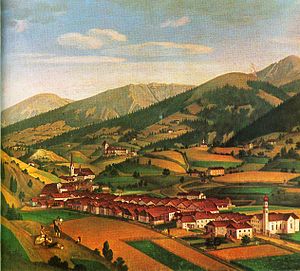Vogelbühel Castle
| Vogelbühel Castle | ||
|---|---|---|
|
The three castles of Matrei: Trautson Castle , Vogelbühel next to it and Raspenbühel Castle further to the left |
||
| Alternative name (s): | front fortress Matrei | |
| Creation time : | around 1200 | |
| Castle type : | Hilltop castle | |
| Conservation status: | Burgstall | |
| Standing position : | Ministeriale | |
| Place: | Matrei am Brenner | |
| Geographical location | 47 ° 8 '23.6 " N , 11 ° 27' 22.3" E | |
|
|
||
The castle Vogelbühel even front Veste Matrei called, is a Outbound hilltop castle in the municipality of Matrei am Brenner in District Innsbruck-Land of Tyrol .
history
This castle is the oldest of the three castles that once existed in this area, including Trautson Castle and Raspenbühel Castle . It was built in the second half of the 12th century and was located on the middle and smallest mountain of these fortified structures, which had a dam function.
Andechser Ministeriale sat at this castle , of which Eberhard, Konrad and Hagen von Matrei were first mentioned in 1209. About the counts of Andechs was for their alleged involvement in the murder of King Philip of Swabia the outlawry pronounced and they had their fiefs in Lower Inn Valley to the Bishop of Brixen cede. Duke Ludwig of Bavaria became the new fiefdom of the county of Unterinntal; this lent the castle to Heinrich von Neiffen , a close relative of the Brixen bishop Bertold von Neifen . In the course of the power struggle for political sovereignty in the Wipptal and Eisack valley between the Bishop of Brixen and Count Albert III. of Tyrol the castle was occupied in 1221 by Heinrich von Matrei, a follower of Albert. However, in the peace treaty of 1221 he had to return the turris in Castro Matrei to Heinrich von Neiffen.
As a result of this dispute, Count Albert had another castle built, which he then gave as a fief to his servants. The Bishop of Brixen was able to obtain a legal division of the servants of Matrei in 1227 and thus grant the front fortress Matrei in 1232 (after the repeal of the imperial ban) to the Counts of Andechs. Count Otto I of Andechs-Meranien († 1234) then enfeoffed Rüdiger von Matrei with it. After Otto's death, only Count Albert III's ministerials appear. here, so that it can be assumed that both castles were in Tyrolean hands (although Count Albert was legally enfeoffed with the county of Lower Inn Valley in 1248). Heinrich von Matrei and then his sons of the same name can again be accepted as castle men. However, due to the expansion of the rear fortress , Trautson Castle, they lost interest in this castle.
Vogelbühel Castle today
Remnants of clay pots make continuous settlement from the Middle Bronze Age to the Middle Ages probable. On the southern slope of the Vogelbühel an extensive cremation grave field was uncovered from the end of the 2nd and the 1st millennium BC. The hill got its name from an abandoned bird barn . Of the former Vogelbühel Castle, only a regularly shaped truncated pyramid can be seen today, which indicates an artificial hill structure. No archaeological finds from the castle have yet been made.
literature
- Oswald Trapp , Magdalena Hörmann-Weingartner (employee): Tiroler Burgenbuch. III. Band - Wipptal . Athesia Publishing House, Bolzano 1974.
Individual evidence
- ↑ Hans-Jörg Kellner, Liselotte Zemmer-Plank, Elisabeth Kellner: A Roman coin treasure from Navis-Mühlen in the Wipptal .
Web links
- Entry on Vogelbühel Castle in the private database "Alle Burgen".

